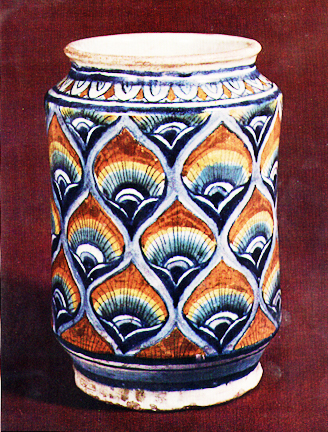Different cities developed individual styles of decoration on albarelli, for example, this colorful 'peacock feather' motif, used in Faenza. By the late 1400's the full palette of polychrome majolica colors was available: blue from cobalt; green from copper; yellow from antimony; brown from iron; and purple from manganese. Painting onto the unfired, powdery majolica glaze was (and is) difficult, with little margin for error. Mistakes are difficult to correct, and once the color has been laid down onto the glaze it is not possible to remove it without the result looking splotchy. A quick, sure brush is the best way to ensure a good result, and this takes years of practice.
There are two theories as to the origin of the name Majolica. The first holds that it is derived from the isle of Majorca, a way-station between Valencia, Spain and Italy. Much of the Hispano-Moresque lusterware pottery was exported from Valencia into Italy via Majorca, and thus, the theory goes, the ware became associated with the island, and its name was corrupted into Italian as Majolica. Alan Caiger-Smith, the British potter and expert on Hispano-Moresque lusterware, believes this theory to be not grounded in fact. Rather, he believes that the name Majolica is instead an Italian corruption of the Spanish phrase, 'obra de málequa,' which literally means, 'luster work.' Thus, málequa became majolica. I personally asked several potters on the island of Majorca what they believed to be the true explanation, and they all professed to not have a clue, but Caiger-Smith's hypothesis does seem plausible.

Albarello (pharmacy jar), Earthenware with Majolica glazing
Faenza, Italy, 1480 CE, 18"ht.


